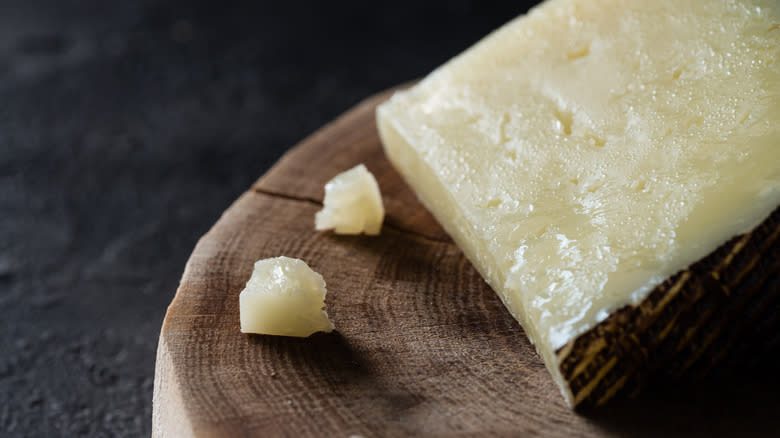The Science Behind Why Your Cheese Sweats

Sweat, tears, or grease -- call the phenomenon whatever you want -- but most people tend to agree that a sweaty block of cheese isn't the most compelling-sounding indulgence. Cheese usually tastes best when served at room temperature, as the flavor molecules within it expand as it warms, releasing the hidden tang and acidity. Still, getting cheese ready to serve isn't as simple as laying it out on the countertop, as this fragile protein is still very prone to that unattractive trait of sweating.
Just like humans sweat when exposed to hot sun, cheese responds to higher temperatures in the same way. Those droplets that suddenly appear on cheese are actually melting butterfat, which will often liquefy when cheese goes through a temperature change. Most often, this process occurs when cheese is transferred from a cold temperature to room temperature. The fast-changing climates cause the cheese's molecules to expand, as previously mentioned, which also sends excess fat onto the surface of the cheese to make room. Over time, this process leads to a less flavorful cheese, as the fat within cheese holds much of its flavor, so it's best to try and prevent cheese sweat from happening in the first place.
While this process is totally natural and primarily an aesthetic concern, it isn't necessarily inevitable. So, to keep your cheese from sweating, here are a few things you can try.
Read more: French Cooking Tricks You Need In Your Life
Protecting Your Cheese From Melting Butterfat

To keep cheese sweat at bay, you need to keep this protein stored correctly in the first place. Keep cheese in a cool and dry area of your fridge, such as the vegetable drawer, to keep humidity away. Also, remember to leave your cheese in its original wrapping to further prevent any excess moisture from growing.
To keep cheese intact once it's ready to serve, timing is key. Don't get your cheese out of the fridge too early. If you're gearing up for a dinner party, you can get your dairy out of its cool environment about an hour prior to the event and only use as much as you think you'll need. A cheese's shelf life decreases each time you remove it from the cold, so it's best to use exact amounts. When you do take your desired amount of cheese out, keep the block wrapped in plastic until your guests arrive. The wrapping helps keep butterfat from leaking out of the cheese as it warms.
Once you're done serving your hors d'oeuvres, place your cheese in an airtight container and immediately put it back in the fridge. Finally, to further prevent sweating for the next time you break out the Gruyere or Swiss, try out this sugar cube hack to absorb the excess moisture that comes with those temperature changes.
If You Can't Stand The Tears, Here's What Cheeses To Avoid

If sweat is still appearing on your cheese while it's in the fridge, then take it out of its wrapper to let it breathe. Now you can blot the moisture away with a paper towel, as the butterfat cannot be reabsorbed, and it'll be as good as new.
Now if you really can't stand the sight of cheese sweat, here are some more suggestions on how to avoid it. The fact is that any cheese has the potential to sweat, but some have it worse than others. If you're extra wary of this phenomenon, steer clear of hard cheeses like cheddar, manchego, or Parmesan. The sweat levels on these cheeses aren't necessarily worse than others, but because of their smooth texture, it's often much more visible. Other cheeses to avoid are those with higher levels of fat, as these obviously have more butterfat to release and will sweat more when conditions allow. This includes cheeses like Colby and Munster. Some lower-fat alternatives to these include mozzarella, ricotta, or feta cheese.
Oftentimes keeping cheese sweat at bay all comes down to storing your cheese the right way, so always do your research before you serve. And hey, even if it's not the most appetizing sight to behold, don't be afraid of a little cheese sweat. After all, it is a natural occurrence. (And just another lucky excuse to eat all of your cheese in one sitting.)
Read the original article on Daily Meal.

